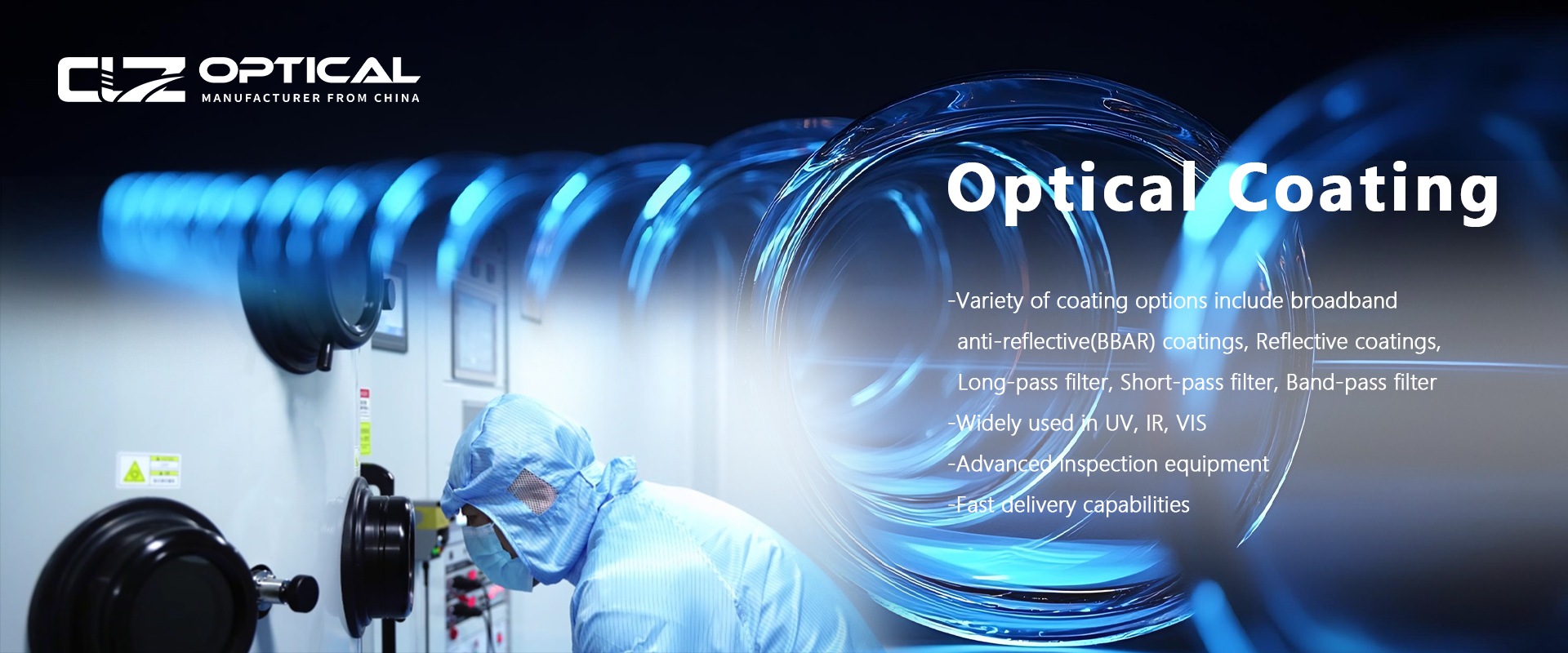Beamsplitter VS Polarizing Beamsplitter: What's the Difference?
Oct. 11, 2025
I. Ordinary Beamsplitter Prisms
Ordinary beamsplitter prisms, also known as non-polarizing beamsplitter prisms, have the core feature of splitting light according to a fixed intensity ratio.
1. Structure and Working Principle:
The classic structure consists of two right-angle glass prisms glued together at their hypotenuses. The key lies in the glued surface, where a special beamsplitter coating is applied. This coating is the "heart" of the prism, its composition and thickness carefully designed to achieve a specific beamsplitting effect by utilizing the principle of optical interference.
When a beam of unpolarized light (i.e., light waves with uniform vibration directions) strikes this coating, it splits the incident light energy into two paths according to a predetermined, fixed ratio: one portion passes through, becoming transmitted light; the other portion is reflected, becoming reflected light. The most common ratio is 50/50 (i.e., half the energy is transmitted and half is reflected), but other ratios, such as 70/30 and 80/20, are also available to meet the needs of different applications.
2. Fundamental Characteristics
- Polarization Insensitivity: Regardless of the polarization state of the incident light (natural light, linearly polarized light, circularly polarized light), as long as the total light intensity is the same, it will split the light in roughly the same proportions. It "sees" the overall energy of the light, regardless of the vibration direction of the optical field.
- Output Light Characteristics: The polarization state of the two beams exiting a conventional beamsplitter prism is typically the same as that of the incident light, or undergoes complex variations, lacking clear polarization characteristics.
There are two main coating technologies for achieving non-polarization beam splitting:
Metallic coatings (such as chromium, aluminum, and silver): These easily achieve neutral beam splitting across a wide spectral range (i.e., a consistent splitting ratio for all colors), but they also have relatively high absorption losses, which can cause light energy to be converted into heat.
Dielectric coatings: These achieve beam splitting through the interference effect of multiple layers of dielectric thin films. Absorption losses are extremely low, but the splitting ratio is generally more sensitive to the wavelength and angle of the incident light.
II. Polarization-Beam-Splitter Cube
The core feature of a polarization-sensitive splitter prism is its ability to separate light based on its polarization state.
1. Structure and Working Principle:
- It is also constructed by bonding two right-angle prisms together, but the bonding surface is coated with a polarization-splitting film. This film consists of multiple dielectric layers and is designed with extreme precision.
- Its operation is based on electromagnetic theory of light, specifically the differing reflection and transmission characteristics of S-polarized and P-polarized light at the interface (the Brewster effect).
-S-polarized light: The light wave's vibration direction is perpendicular to the plane of incidence (i.e., "normal" to the incident plane).
-P-polarized light: The light wave's vibration direction is parallel to the incident plane (i.e., lying within the incident plane).
-Polarization splitting film is designed to produce extremely high reflectivity (>99%) for S-polarized light and extremely high transmittance (>95%) for P-polarized light at a specific angle (usually 45 degrees of incidence).
To better understand S-light and P-light, we first need to understand the state of the most common natural light—unpolarized light.
1) Definition:
Unpolarized light, also known as natural light, refers to light waves whose electric field vector oscillates uniformly and randomly in all directions within a plane perpendicular to their propagation direction.
2) Physical Image:
A beam of unpolarized light can be viewed as a mixture of countless linearly polarized light beams. The vibration directions of these linearly polarized light beams are uniformly distributed within a 360-degree plane and have no fixed phase relationship between them.
3) Common Sources:
Light emitted by common light sources such as the sun, incandescent lamps, and LED lights is unpolarized light. This is because the light they emit is generated by numerous independent atomic or molecular transitions. The vibration directions of these microscopic luminous events are random, ultimately composing a beam of light that oscillates uniformly in all directions.
S-light and P-light
Both S-light and P-light are linearly polarized light, and their definitions depend entirely on a reference frame called the plane of incidence.
The plane of incidence is the plane formed by the incident light and the normal to the surface of the medium. You can imagine it as a vertical "wall" that contains the path of the light entering at an angle.
Within this reference frame, we define two polarization directions:
1) S-light: The electric field vibrates perpendicular to the plane of incidence.
S-light = light perpendicular (Senkrecht) to the plane of incidence. Sometimes also called a "transverse electric wave."
2) P-light: The electric field vibrates parallel to the plane of incidence.
P-light = light parallel (parallel) to the plane of incidence. Sometimes also called a "transverse magnetic wave."
The directions of S and P are relative, depending on how the light strikes the surface (i.e., the orientation of the plane of incidence). The same beam of linearly polarized light, if incident at different angles, can be S, P, or a combination of both.
A beam of unpolarized light can be decomposed into a mixture of S and P components of equal intensity.
2. Fundamental Characteristics
Highly polarization-sensitive: Its spectroscopic behavior depends entirely on the polarization state of the incident light.
-When a beam of natural light (a mixture of light with all polarization directions) is incident, it is "purified" and separated: the S-polarized component is reflected, and the P-polarized component is transmitted, resulting in two linearly polarized beams with mutually perpendicular polarization directions.
-When a linearly polarized light beam is incident, its final optical path depends on the angle between its polarization direction and the S and P directions. It can be used as a polarization-controlled optical switch.
III. Application Fields of Spectral Prisms and Polarizing Spectral Prisms
Due to their fundamentally different operating principles, the two types have distinct application fields.
Application of ordinary beam splitters: Mainly used in situations where only light intensity is concerned but polarization state needs to be changed.
1. Optical Interference System:
The most typical application is the Michelson interferometer. A laser beam is split by a beamsplitter into two beams of similar intensity (reference beam and measurement beam). These beams travel different paths and then interfere with each other. Energy equipartition is required; polarization is irrelevant.
2. Beam Replication and Sampling:
In laser processing and optical measurement, a primary laser beam needs to be split into multiple paths for simultaneous processing or monitoring. Common beamsplitters can conveniently achieve beam replication and energy distribution.
-Laser Power/Energy Monitoring: Using a common beamsplitter with a known splitting ratio (e.g., 99/1), 1% of the primary beam's energy is reflected onto a detector, enabling non-destructive, real-time monitoring of the primary laser's power.
3. Imaging and Display System:
In traditional digital SLR cameras, a flat beamsplitter (operating on the same principle as a cubic prism) reflects part of the beam to the autofocus sensor and transmits the remaining beam to the main imaging sensor or viewfinder.
In some simple projection optical paths, it is used to combine different colors of light.
Applications of Polarization Beamsplitters: Polarization beamsplitters are core components in all applications that require manipulation, detection or utilization of the polarization state of light.
1. Liquid Crystal Projectors:
- This is the most classic and widespread application of polarization-based light (PBS). The projector's light source emits unpolarized light, which first passes through a PBS (or a combination of other polarization elements) to produce uniform linearly polarized light.
2. Optical Isolators and Circulators:
In fiber-optic communications and precision laser experiments, it is necessary to prevent reflected light from returning to the laser to prevent instability or damage. A core component of an optical isolator is a PBS. It works with a magneto-optical crystal (Faraday rotator) to ensure that the polarization states of the forward and reverse light differ. The PBS then directs the reflected light off the main optical path, achieving unidirectional light transmission.
3. Quantum Optics and Quantum Information:
In quantum computing and quantum communication, the polarization state of photons is one of the key methods for encoding quantum information (qubits). PBS is used to generate, manipulate, and measure the polarization state of photons and is a key device for quantum logic operations and Bell state analysis.
4. Polarization Measurement and Sensing:
In materials science, chemistry, and biological research, it is necessary to measure the polarization properties of samples (such as optical rotation and birefringence). PBS can serve as a core component in polarization state generation and analysis systems and is used in the construction of precision instruments such as ellipsometers.




















